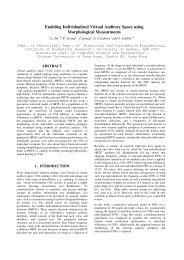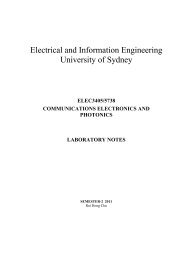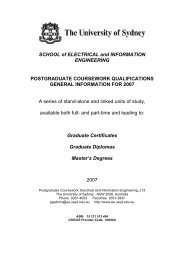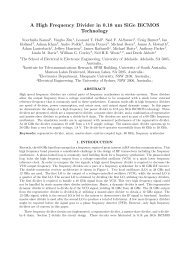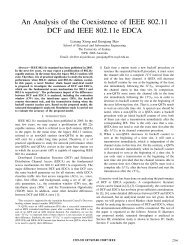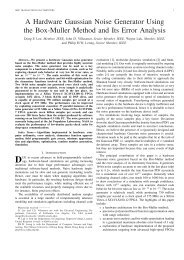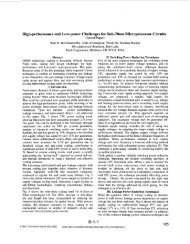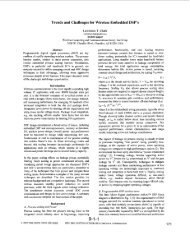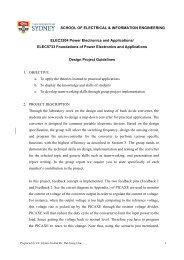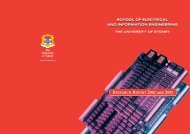Near-capacity turbo trellis coded modulation design based on union ...
Near-capacity turbo trellis coded modulation design based on union ...
Near-capacity turbo trellis coded modulation design based on union ...
You also want an ePaper? Increase the reach of your titles
YUMPU automatically turns print PDFs into web optimized ePapers that Google loves.
2038 IEEE TRANSACTIONS ON COMMUNICATIONS, VOL. 56, NO. 12, DECEMBER 2008<br />
BER<br />
1<br />
10 -1<br />
10 -2<br />
10 -3<br />
10 -4<br />
10 -5<br />
10 -6<br />
ttcmiq-xfad-ber-bound.gle<br />
8PSK<br />
[13 2 4] 8<br />
16QAM<br />
[27 2 4 10] 8<br />
32QAM<br />
[41241020] 8<br />
64QAM<br />
[4124102040]<br />
Capacity<br />
Bound<br />
5.38dB, =2<br />
7.21dB, =3<br />
9.98dB, =4<br />
10 -7<br />
4 6 8 10 12 14 16<br />
E b /N 0 [dB]<br />
Fig. 11. The BER and the error floor bound performance of the various<br />
IQ-TTCM schemes when communicating over uncorrelated Rayleigh fading<br />
channels using a block length of N =10, 000 symbols. The product distance<br />
spectrum and Hamming distance spectrum used for generating the uni<strong>on</strong><br />
bound was truncated at Δ P max =60and Δ H max =6, respectively.<br />
c<strong>on</strong>vergence due to having a closed tunnel in its EXIT chart.<br />
Hence, the BER performance of the 16QAM TTCM scheme<br />
employing the proposed GP of [272410] 8 is significantly<br />
better than that of the benchmarkers, as it is evidenced in<br />
Fig 8.<br />
As depicted in Fig. 11, when we increased the block length<br />
to N =10, 000 symbols, the IQ-TTCM schemes exhibit lower<br />
error floors and a decoding c<strong>on</strong>vergence closer to the estimated<br />
thresholds summarised in Tab. I, compared to the scenario<br />
using a block length of N = 1000 symbols, as shown in<br />
Figs. 7 to 10. Hence, <str<strong>on</strong>g>capacity</str<strong>on</strong>g>-approaching TTCM schemes<br />
can be successfully <str<strong>on</strong>g>design</str<strong>on</strong>g>ed <str<strong>on</strong>g>based</str<strong>on</strong>g> <strong>on</strong> the proposed symbol<str<strong>on</strong>g>based</str<strong>on</strong>g><br />
EXIT chart aided and the truncated uni<strong>on</strong> bound assisted<br />
code <str<strong>on</strong>g>design</str<strong>on</strong>g>. Furthermore, the proposed technique may also be<br />
employed for <str<strong>on</strong>g>design</str<strong>on</strong>g>ing symbol-interleaved space-time TTCM<br />
schemes for approaching the multiple-input multiple-output<br />
channel <str<strong>on</strong>g>capacity</str<strong>on</strong>g>.<br />
VII. CONCLUSIONS<br />
We have <str<strong>on</strong>g>design</str<strong>on</strong>g>ed <str<strong>on</strong>g>capacity</str<strong>on</strong>g>-approaching TTCM schemes by<br />
performing a search for good c<strong>on</strong>stituent TCM comp<strong>on</strong>ent<br />
codes with the aid of symbol-<str<strong>on</strong>g>based</str<strong>on</strong>g> EXIT charts and truncated<br />
symbol-<str<strong>on</strong>g>based</str<strong>on</strong>g> uni<strong>on</strong> bounds. The prime <str<strong>on</strong>g>design</str<strong>on</strong>g> criteri<strong>on</strong> of<br />
<str<strong>on</strong>g>capacity</str<strong>on</strong>g>-approaching TTCM schemes is that of finding an<br />
open tunnel in the corresp<strong>on</strong>ding EXIT charts at the lowest<br />
possible SNR values, while maintaining a sufficiently low<br />
error floor, rather than maximising the ‘punctured’ minimal<br />
distance of the c<strong>on</strong>stituent codes [4]. Hence, we can reduce<br />
the code search space by fixing the feed-forward GPs and then<br />
search for the best feed-back GP that provides an open tunnel<br />
in the EXIT chart at the lowest possible SNR value. Although<br />
the independence of the extrinsic informati<strong>on</strong> and systematic<br />
informati<strong>on</strong> is not always satisfied by the symbol-<str<strong>on</strong>g>based</str<strong>on</strong>g> TTCM<br />
scheme, most of the good c<strong>on</strong>stituent codes found assist the<br />
TTCM schemes in performing near the channel <str<strong>on</strong>g>capacity</str<strong>on</strong>g>.<br />
12.71dB, =5<br />
APPENDIX<br />
The set χ = χ(y, m) ={z} in Eq. (19) can be generated<br />
by using the following recursive functi<strong>on</strong>:<br />
Find Symbol Error Set(y, m, χ, 0), which is defined as:<br />
Find Symbol Error Set(int ỹ,intb,int*χ,int¯z){<br />
if(b =1)add(¯z +ỹ)intoχ<br />
else {<br />
⌊ ⌋<br />
for (z b =0; z b ≤ ỹ<br />
b<br />
; z b ++)<br />
Find Symbol Error Set(ỹ − b · z b , b − 1, χ, ¯z + z b )<br />
}<br />
return<br />
}<br />
where the values of the variables ỹ, b and ¯z could change<br />
during the transiti<strong>on</strong> from the parent loop to the child loops.<br />
REFERENCES<br />
[1] G. Ungerböck, “Channel coding with multilevel/phase signals,” IEEE<br />
Trans. Inform. Theory, vol. 28, pp. 55–67, Jan. 1982.<br />
[2] D. Divsalar and M. K. Sim<strong>on</strong>, “The <str<strong>on</strong>g>design</str<strong>on</strong>g> of <str<strong>on</strong>g>trellis</str<strong>on</strong>g> <str<strong>on</strong>g>coded</str<strong>on</strong>g> MPSK for<br />
fading channel: performance criteria,” IEEE Trans. Commun., vol. 36,<br />
pp. 1004–1012, Sept. 1988.<br />
[3] ——, “The <str<strong>on</strong>g>design</str<strong>on</strong>g> of <str<strong>on</strong>g>trellis</str<strong>on</strong>g> <str<strong>on</strong>g>coded</str<strong>on</strong>g> MPSK for fading channel: Set<br />
partiti<strong>on</strong>ing for optimum code <str<strong>on</strong>g>design</str<strong>on</strong>g>,” IEEE Trans. Commun., vol. 36,<br />
pp. 1013–1021, Sept. 1988.<br />
[4] P. Roberts<strong>on</strong> and T. Wörz, “Bandwidth-efficient <str<strong>on</strong>g>turbo</str<strong>on</strong>g> <str<strong>on</strong>g>trellis</str<strong>on</strong>g>-<str<strong>on</strong>g>coded</str<strong>on</strong>g><br />
<str<strong>on</strong>g>modulati<strong>on</strong></str<strong>on</strong>g> using punctured comp<strong>on</strong>ent codes,” IEEE J. Select. Areas<br />
Commun., vol. 16, no. 2, pp. 206–218, Feb. 1998.<br />
[5] C. Berrou, A. Glavieux, and P. Thitimajshima, “<str<strong>on</strong>g>Near</str<strong>on</strong>g> Shann<strong>on</strong> limit<br />
error-correcting coding and decoding: <str<strong>on</strong>g>turbo</str<strong>on</strong>g> codes,” in Proc. IEEE<br />
Internati<strong>on</strong>al C<strong>on</strong>ference <strong>on</strong> Communicati<strong>on</strong>s, 1993, pp. 1064–1070.<br />
[6] L. Hanzo, S. X. Ng, W. Webb, and T. Keller, Quadrature Amplitude<br />
Modulati<strong>on</strong>: From Basics to Adaptive Trellis-Coded, Turbo-Equalised<br />
and Space-Time Coded OFDM, CDMA and MC-CDMA Systems, Sec<strong>on</strong>d<br />
Editi<strong>on</strong>. New York: John Wiley and S<strong>on</strong>s, 2004.<br />
[7] S. X. Ng, T. H. Liew, L.-L. Yang, and L. Hanzo, “Comparative study of<br />
TCM, TTCM, BICM and BICM-ID schemes,” in Proc. IEEE Vehicular<br />
Technology C<strong>on</strong>ference, Rhodes, Greece, May 2001, pp. 2450–2454.<br />
[8] E. Zehavi, “8-PSK <str<strong>on</strong>g>trellis</str<strong>on</strong>g> codes for a Rayleigh fading channel,” IEEE<br />
Trans. Commun., vol. 40, pp. 873–883, May 1992.<br />
[9] S. Le Goff, A. Glavieux, and C. Berrou, “Turbo-codes and high spectral<br />
efficiency <str<strong>on</strong>g>modulati<strong>on</strong></str<strong>on</strong>g>,” in Proc. IEEE Internati<strong>on</strong>al C<strong>on</strong>ference <strong>on</strong><br />
Communicati<strong>on</strong>s, 1994, pp. 645–649.<br />
[10] T. Duman and M. Salehi, “The uni<strong>on</strong> bound for <str<strong>on</strong>g>turbo</str<strong>on</strong>g>-<str<strong>on</strong>g>coded</str<strong>on</strong>g> <str<strong>on</strong>g>modulati<strong>on</strong></str<strong>on</strong>g><br />
systems over fading channels,” IEEE Trans. Commun., vol. 47, no. 10,<br />
pp. 1495–1502, Oct. 1999.<br />
[11] C. Fragouli and R. D. Wesel, “Turbo-encoder <str<strong>on</strong>g>design</str<strong>on</strong>g> for symbolinterleaved<br />
parallel c<strong>on</strong>catenated <str<strong>on</strong>g>trellis</str<strong>on</strong>g>-<str<strong>on</strong>g>coded</str<strong>on</strong>g> <str<strong>on</strong>g>modulati<strong>on</strong></str<strong>on</strong>g>,” IEEE Trans.<br />
Commun., vol. 49, no. 3, pp. 425–435, Mar. 2001.<br />
[12] B. Scanavino, G. M<strong>on</strong>torsi, and S. Benedetto, “C<strong>on</strong>vergence properties<br />
of iterative decoders working at bit and symbol level,” in Proc. IEEE<br />
Globecom, San Ant<strong>on</strong>io, TX, Nov. 2001, pp. 1037–1041.<br />
[13] J. Boutros and E. Viterbo, “A power- and bandwidth-efficient diversity<br />
technique for the Rayleigh fading channel,” IEEE Trans. Inform. Theory,<br />
vol. 44, no. 4, pp. 1453–1467, July 1998.<br />
[14] B. D. Jelicic and S. Roy, “Design of <str<strong>on</strong>g>trellis</str<strong>on</strong>g> <str<strong>on</strong>g>coded</str<strong>on</strong>g> QAM for flat fading<br />
and AWGN channels,” IEEE Trans. Veh. Techn., vol.44,no.1,pp.<br />
192–201, Feb. 1994.<br />
[15] S. X. Ng and L. Hanzo, “Space-time IQ-interleaved TCM and TTCM<br />
for AWGN and Rayleigh fading channels,” IEE Electr<strong>on</strong>. Lett., vol. 38,<br />
pp. 1553–1555, Nov. 2002.<br />
[16] J. Yuan, B. Vucetic, and W. Feng, “Combined <str<strong>on</strong>g>turbo</str<strong>on</strong>g> codes and interleaver<br />
<str<strong>on</strong>g>design</str<strong>on</strong>g>,” IEEE Trans. Commun., vol. 47, no. 4, pp. 484–487, Apr.<br />
1999.<br />
[17] W. Feng, J. Yuan. and B. Vucetic, “A code-matched interleaver <str<strong>on</strong>g>design</str<strong>on</strong>g><br />
for <str<strong>on</strong>g>turbo</str<strong>on</strong>g> codes,” IEEE Trans. Commun., vol. 50, no. 6, pp. 926–937,<br />
June 2002.<br />
[18] S. X. Ng, T. H. Liew, L-L. Yang, and L. Hanzo, “Binary BCH <str<strong>on</strong>g>turbo</str<strong>on</strong>g><br />
coding performance: uni<strong>on</strong> bound and simulati<strong>on</strong> results,” in Proc. IEEE<br />
Vehicular Technology C<strong>on</strong>ference, Tokyo, Japan, May 2000, pp. 849–<br />
853.<br />
Authorized licensed use limited to: UNIVERSITY OF SYDNEY. Downloaded <strong>on</strong> January 4, 2009 at 20:22 from IEEE Xplore. Restricti<strong>on</strong>s apply.



